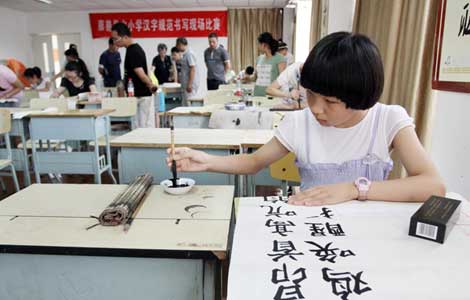From the tree to the pot
Updated: 2013-08-20 08:07
By Sun Li and He Na (China Daily)
|
||||||||
The intricate production procedure used to make Dahongpao tea consists of 18 steps and undoubtedly contributes to the distinctive, long-lasting aroma. The following labor-intensive processes are among the most important factors that can affect quality.
The leaves should be picked in late spring and those selected should not be too tender, otherwise the tea will taste bitter.
The chosen leaves are then spread out on flat beds or placed in bamboo baskets before being left in direct sunlight to remove any lingering moisture. This process, called "withering", plays an important role in determining whether the tea will have a lasting aroma. The leaves are withered until the luster is lost and the fragrance is dominant.
The most important part of the process comes when the leaves are placed in special baskets and shaken vigorously. This affects the quality in terms of leaf shape and flavor.
Because the violence and duration of the shaking process need to be adjusted according to the time of harvest and changes in the color of the leaves, the procedure is usually only carried out by veteran blenders of great experience.
Each basket is shaken between four and eight times before it's put down and the master starts on another batch. The entire process can take as long as six to nine hours.
As they're being shaken, the leaves bump against each other, which bruises the edges, destroying the cell structure in the leaves and accelerating oxidization to reduce the naturally grassy smell.
Later, any residual moisture is removed by the baking process, which is divided into two parts. This process enhances the color and aroma of the tea.
During the first part of the procedure, the leaves are heated to more than 120 C for approximately 10 minutes, then they are exposed to the air for around 30 minutes. During the second firing, the heat is reduced to 90 C and the leaves are baked for roughly 20 minutes.
In the final stage of the process, the leaves are sorted to remove sub-standard leaves or twigs.

 Merkel makes historic visit to Nazis' Dachau camp
Merkel makes historic visit to Nazis' Dachau camp
 Chinese fleet sets sail for joint drills
Chinese fleet sets sail for joint drills
 President Xi meets WHO director-general
President Xi meets WHO director-general
 Everyman movie star
Everyman movie star
 Rural boarding schools need dorm managers
Rural boarding schools need dorm managers
 Center of hope and support
Center of hope and support
 Chinese characters under threat in digital age
Chinese characters under threat in digital age
 US, China to expand military exchanges
US, China to expand military exchanges
Most Viewed
Editor's Picks

|

|

|

|

|

|
Today's Top News
Dispute slows positive trend on Korean Peninsula
Expanded Sino-US exchanges to stabilize ties
Chinese fleet sets sail for joint drills
Premier Li stresses need for reform
Children with HIV live in fear
Kidney trafficking operation smashed
Food safety tops public's concerns
Monkeys at park given contraceptives
US Weekly

|

|







